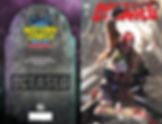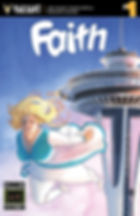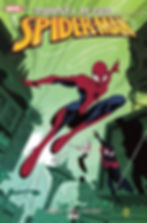The Strange Business of Variant Covers: Pt 3- Store Exclusives
- Trusty Henchman
- Oct 24, 2020
- 8 min read
Updated: Oct 25, 2020

I previously mentioned retailer exclusive variants so I wanted to commit a full piece on it as they have actually become a pretty big part of the industry over the past decade or so. It's also something our storefronts dabbled in as before we shut down we have had twelve unique store variants and shared a few limited edition designs with other retailers as well.
To quickly summarize the idea, comic retailers may sometimes request the printing of unique and limited print runs of new comics with a cover that's exclusive to their storefronts. There are a few hoops and restrictions you usually have to jump through, but there's also a host of positive reasons to go through the trouble of getting a store exclusive. I'll give a bit of a breakdown on the balance of positives and negatives using some of our experiences, starting with our first and most successful exclusive.

When the Comics Dungeon first decided to take the step into playing with the exclusive variant market we had reached out to Image Comics as 2014/2015 had seen a huge rise in their sales. DC was floundering in the New 52 era and Marvel wasn't doing much better, and Saga had basically absorbed the bulk of our subscribers that were desperate for quality comics. We reached out to the director of retail sales at Image at the time and after some discussion we landed on getting an exclusive cover to the upcoming Jeff Lemire/Dustin Nguyen sci-fi title Descender.

It was due for an early March release, so the timing was great as it set us up to take the book to Emerald City Comicon. We worked in conjunction with the con to promote the book, so the added advertising, the timing, the talents (both creators were at the con that year if I recall correctly), and everything lined up perfectly. The only hitch was that Diamond Comics (our distributor) lost a chunk of books in shipping that were thankfully found at the last minute, but that's a story for another time.
The book was a hit and eventually became another strong subscription title at our store. This actually helped to bolster Image as a core publisher in sales for a good chunk of time moving forward. With all the hype and popularity of the creators, we sold through all of our variants with a combination of pre-orders to our regular customer base, mail orders, and a complete sell through at the convention. It is the one and only store exclusive cover that we pretty much had a 100% sell through on, so we definitely had the motivation to keep trying after that success.
The trick is, you just never know what's going to hit big. Since Descender we never had any major failures, but some covers never quite found their audience. One of my favorites, our Sara Richards cover to Godzilla In Hell #1, was unfortunately one of our slowest selling variants.

So with each new prospect we really had to take into account the logistics of what was required for each variant. While it's different for each publisher, here's a quick break down of some factors:
-Minimum order requirements: The minimum for Descender #1 was 1000 copies, while the mean average at publishers such as IDW, Valiant, and Oni was around 1200. We explored the possibility of variants at DC and Marvel a few times, and their requirements were in the range of 2000-3500 (although it sounds like they have been softening those numbers recently).
-Unlocking the variant gates: In most cases if there are ratio variants (discussed in our last installment) also available for that issue you are getting an exclusive cover of, then your order of your cover qualifies you for getting those ratio covers. So if you order 1000 copies of your own cover of My Little Pony: Ponypocalypse Now #1 drawn by Rob Liefeld, then you qualify to also get ten copies of the 1:100 ratio variant drawn by Frank Miller and forty copies of the 1:25 variant by Todd McFarlane. And then just think about all that Frank Miller money you'll be making. All joking aside though, securing these other high end covers goes a long way in recouping the risk you took on the bulk of the order, something I'll chat about a bit later.
-Choice of cover artist: Now this mostly just depends on the publisher, but at times it may also depend on the clout of the store. There's a reason Midtown Comics gets a lot of J. Scott Campbell variants, while we never would have a chance to have access to him short of blackmail. And believe me, I'm not completely above that option.
In the case of our dealings with Oni when we got our Invader Zim cover, we never really had an option. Due to the nature of it being a franchise property owned by Nickelodeon, Oni gave us the early stipulation that we could only agree to a pre-existing option done in a desired house style, which was fine and we were down.


In the case of working with Valiant, we had a number of options. In some cases we could choose from a pool of pre-existing artwork (with a time limit as other stores could choose from the same pool), or we could choose our own artist. In cases where we choose our own artist, a certain commision fee also went into the overall charge of the project to cover the artist ($200-800 as an average). For our first Valiant variant, The Book of Death #1, we choose from the pool of options they had ready to go.
We had a great experience working with Valiant and did a number of variants with them over the next few years, often times choosing local Seattle based talents such as Kelly & Nichole Matthews for four connecting tour-of-Seattle covers to the Faith mini-series:

As well as Robert Tritthardt for our Bloodshot Salvation #1 cover:

IDW had an easy system as well for when we got our Godzilla cover, and they were great to work with when we had Corey Lewis do a cover for Marvel Action: Spider-Man #1:

In the case of that last one, we did have the complication of IDW reporting to Marvel for the final product, but it was relatively painless. We had a similar issue with our Star Wars variant from IDW, where in the early draft by Mike Maihack the character Rey was depicted with a forlorn look on her face. The judgement from above was that she needed to have a slightly happier look on her face, considering the all-ages nature of the project. Which y'know, as cringy as it is that someone decided the lead female had to smile because it would look better (despite the context of her situation), it was an easy fix for Maihack to achieve final approval.

So in summary, each publisher has its own rules and limitations for who does your covers and how, so you just have to be willing to be patient and play ball.
So those are some ground rules, but what about the overall cost? Well, it often comes down to the size of your account with Diamond Comics and the set discount tiers you already exist within. In most cases, the cost of our books was about $2-3. So on the low end, with a min order of let's say 1200, you're paying $2400 + the potential commision fee (and then let's not forget the shipping cost of this bulk which is nearly impossible to figure out from Diamond's end because of the mess they call a shipping system). So let's land at roughly $3k for a smaller run from a smaller publisher.
On the Marvel/DC side you're probably looking at more towards $5-6k. Last time I checked there were some requirements to also get a B&W and/or Virgin version of your cover. Those may be non-applicable now and I could be mis-remembering some elements, but either way this is already a considerably higher cost risk.

Which leads us to the major issue with all of this discussion on exclusive variants; is the risk worth it? In the case of Descender, yes it most definitely was worth it. But as with all ordering in this industry, are you actually able to separate your personal tastes from making objective stocking decisions? Will a franchise property be a safer bet than a new concept/title? Will the style of the artist you choose click with the fanbase? Will people buy this comic solely because there is a cat on it?
The short answer to that one is yes, but not really in the numbers you would hope for the long term.
Because let's say you made your cost back fairly quickly, and even turned a profit. If you didn't sell through all 1200 copies of your exclusive comic (which seriously, selling 100 copies of a normal book is a slight miracle for most moderately sized stores), then you have to store the remnants. And I can tell you firsthand that you can build some really nice little fortresses with all those boxes of comics, but they sure do get in your way when you have limited square footage.
Quick note on recouping costs, I mentioned earlier that if your exclusive cover opened the access to gateway variants then that could speed up your process a bit. For us that was definitely the case with the Marvel Action: Spider-Man covers. IDW had also created variants by Kevin Eastman (of TMNT fame) plus some foil covers, so we were able to quickly secure some solid turn around on those to help cover the cost of the bulk order.

There are of course numerous other benefits to doing store exclusive covers. Besides often opening the gates to more variants, retailers may enjoy:
-The additional advertising that comes with selling covers by popular artists online. -They can be used as a sort of marketing tool, to be included in PR packets for example. -They may increase your Diamond discount for your monthly order. -They are tradable with other stores so that you can expand on your inventory with other exclusive variants. -They're great to stock at conventions as they also work as tourist gifts. Hey, there's a reason the Space Needle made it into most of our covers.
All of this is still just supplemental to the core motivation, which is increasing sales by appealing to the collector market. Variant sales online are a huge percentage of sales to giants like Midtown Comics, and the more of a range of exclusive inventory you have then the more opportunities for sales, promos, and incentives to draw more traffic in.
I haven't even mentioned that creators such as J. Scott Campbell, Artgerm, and Alex Ross have their own web stores where they sell their own exclusive covers. The collector market often hinges on the artists, commodifying their name into a peak sales pitch that instantly calls upon legions of fans with disposable incomes. When Artgerm does a special cover, fans line up to buy every version of that cover they can find. Sell four different versions at $30 each, or the bundle for $100, what a deal!

Another rising star in the comic cover business, Peach Momoko, recently signed an exclusive contract with Marvel. Her covers alone have jumpstarted online sales for fringe new comics that in previous years would have probably faded away into obscurity upon the day of their release. Marvel knows what's up. If a trend shows people buying your comics solely for one cover artist, you should probably try to lock that talent down ASAP.
Exclusivity is it's own sort of fetish these days, working hand in hand with the fetishization of collectible comics which are sealed away and preserved in so much mylar. Publishers are desperately trying to increase their bulk numbers, so once it became obvious that this is where the market was they eagerly played into it. Why shouldn't they? Money is money and units sold are units sold. If the market clamors for twenty covers to the same book then who are they to say no?
I probably got a lot more cynical at the end here than I originally intended, but my point is that as variants became more and more commonplace over the past few decades then the comic retail marketplace actually adapted and morphed in new ways to supplement and thrive off of this demand. For good and bad, variants and exclusive variants are now an exceptionally strong cornerstone of this industry's cashflow. So much so that at this point I'm not entirely sure we can ever divorce ourselves from the production of variants.
That's all I got on this particular aspect for the moment. My next focus down the line will be on the proliferation of cover artists as a part of this entire system. I find that the rise of talents as industry sales influencers through the allure of their cover art alone to be fascinating.
And if you were wondering what happened to the 1:1000 Mike Mignola variant to My Little Pony: Ponypocalypse Now #1, I already claimed that one so you can bugger off.






